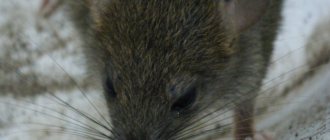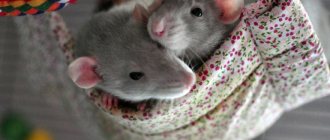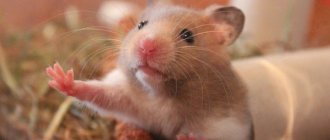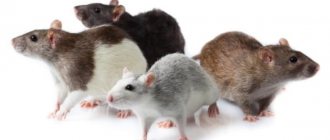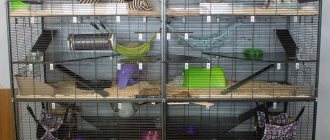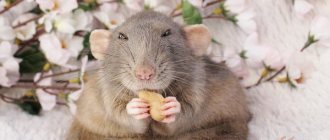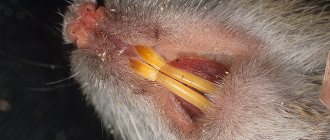Visual orientation
The rat's vision has its own characteristics, complemented by the characteristics of the brain and thinking. The animal is well oriented in the space familiar to it, since it remembers the location of objects.
A study was conducted where rodents moved through a maze. After the structure was turned over, the animals strayed from their intended course. When the objects were moved along with the maze, the rodents behaved as usual.
Pests can clearly see objects located at a distance of 50 cm. They distinguish whether the path ahead is clear within 75 cm. To determine the closer location of objects, they use the organs of touch - the mustache.
What kind of vision do rats need to know in order to outwit rodents and get rid of them in a timely manner? It is also worth considering that as animals age, their vision decreases. Rats do not live long, so their vision begins to deteriorate after 2 years of life. This explains the fact that older individuals are more likely to fall into a trap.
Pet age in human years
In terms of the human life cycle, a pet rat will live somewhere between 3-5 years.
Humans are considered elderly starting at about 60 years of age, which would be about two years of age for a rat. Old age is a guarantee of decreased performance and mobility; therefore, it is a good way to determine the general age of a pet rat. One day in the life of a rat is equal to 26.7 days in human years, which is approximately 1 human day equal to a month in the lifespan of a rat. With this in mind, you can expect a rat's physical performance to decline after about 2 years, which is essentially a sign of old age.
Do rodents see colors?
The human eye contains two types of light receptors:
- rods (perceive dim light, provide the ability to see in the dark);
- cones (catch bright light, distinguish a range of colors).
The rat eye contains the same receptors, but unlike human ones, they are located less closely to each other. This feature is reflected in color perception. The retina of the animal’s eyes perceives the following types of spectra:
- medium wave;
- shortwave;
- ultraviolet.
Rats can only distinguish between green and blue colors, and do not recognize shades.
The density of receptors is not the only difference between the retina of humans and rodents. Another difference is the ratio. If humans have cones 5% of the total number of receptors, then rats have only 1%. Thus, 99% of rat receptors are rods.
It is worth noting that the structure of the eyes does not allow rats to distinguish colors. The world for these animals does not play with bright colors. Vision in rats is based on the perception and assessment of the brightness and dimness of light radiation.
What color are a rat's eyes?
Albinism is a genetic defect. The animal's body is not capable of producing melanin, or coloring pigment. It is absent from the iris of the eyes, and the blood vessels are translucent. The eyes look red and scary.
Albino rats suffer from poor eyesight. To catch the picture, they slowly turn their head. It is difficult for them to focus on any object. White pets are practically blind, and have poor color saturation perception with a value of 20/1200. By comparison, individuals with normal pigmentation have 20/600 vision.
Fact 1: Rat vision – external and internal
In order to imagine how rats see, it is enough to recall human colorblind people with extreme manifestations of the disease. Animals practically do not distinguish colors; the whole world for them is a collection of spots of different sizes and intensities that are in motion. Rodents' external vision is very poor, but they don't need it. Rats hear perfectly, distinguishing the direction and distance of even a subtle rustle, and can determine its cause. In addition, the animals have a delicate sense of smell and touch.
There is another incredible fact. Scientific experiments with rats have shown that test subjects have inner vision. In humans, this is called premonition, or the ability to see possible developments of events. This theory is supported by a well-known fact: rodents, which live in large numbers on board a ship, leave before it sinks. There are also more specific confirmations. For example, in the Stalingrad hell, animals left the city en masse before the next air raid. They also feel nuclear tests, running away from test sites several hours before the events.
Visual orientation
In the studied territory, the animal orients itself well - visual memory is responsible for this, where the location of surrounding objects is recorded. That is, if you rearrange objects around the rodent, it will lose orientation in space.
In conclusion, it is worth noting a few more interesting features. The animals see well within half a meter. They can see obstacles in their path only at a distance of up to 75 cm. The older the individual, the worse it sees - only animals under two years old have good vision by rat standards.
Gnaws everything in sight
And the trouble is not only in our heroine’s good appetite. The rat needs to grind its teeth all the time - after all, its incisors are constantly growing at a speed of up to 2-3 mm per week
And God forbid if they get their teeth into something super important!
Once in Japan, a rat stopped 16 trains on the Tokyo-Osaka line. The investigation into the case showed that the scoundrel chewed through the alarm cable and turned off the traffic lights.
In the house of an altapress.ru friend, a rat named Krysya chewed the phone buttons, the Mac keyboard and got to the computer mouse. The battle between the rat and the mouse ended with the acquisition of new and expensive peripheral devices, and the hooligan was briefly placed in an isolation ward - a cage.
Isolating it is the only way out, because it is hardly possible to hide anything from this creature. She easily jumps to a height of up to a meter, makes her way between vertical surfaces to the target, and moves through pipes. And at the same time, he easily remembers the most winding path, feeling comfortable in city communications.
Rat.
visualhunt.com
Features of Ultraviolet Vision
The rat's eyes are under study. In the course of numerous studies, some features of how different types of rats look at the world around them have become known.
- They see urine marks. Animals detect traces of urine left by smell and color. In the dark, the discharge is visible under ultraviolet light. Predators mark their territory in this way.
- They see the body in ultraviolet light. Different parts of the animal and human body emit ultraviolet light of different wavelengths.
Interesting!
In an animal like a degu, the stomach emits longer ultraviolet rays. When he sleeps, he shows his belly to his relatives. During the hunt, the animal is on 4 legs, its back makes it invisible in the dark.
Important!
Rats see the picture blurry. The visual acuity of a rodent is 30 times less than that of a human. Albinos have red eyes 40 times. Depth of field from 7 cm to infinity. In humans - from 2.3 m. This suggests that rodents see only at a short distance.
Capable of mutual assistance
There is an opinion that in nature, everyone is for himself, the fittest survives, etc. All this is a big simplification. And rats are proof of this.
Neuroscientist Peggy Mason of the University of Chicago was surprised to discover that rats will help each other if one of them is in trouble. The basis of his conclusions is unclear, but he concluded: rats have empathy for each other.
Other scientists have also become convinced that mutual aid is practiced in a rat society. They report: rats have nurseries for babies and a kind of “nursing home” - providing food for old blind animals. It was even noted that in case of danger, old rats are escorted to a secluded place.
However, with all this, rats can devour a sick relative without a twinge of conscience. Yes, rats are cannibals. The villainous mother also does not hesitate to eat her weak and sick children. But she is caring towards others and keeps the nest clean.
Rat. Rat. visualhunt.com Rat. visualhunt.com
Characteristics of panoramic perception
To compensate for myopia, rodents are given panoramic perception. The eyes of the animals are located on the sides of the muzzle. This arrangement provides expanded visual coverage of the territory.
It is worth noting that in animals the pictures that each eye sees do not coincide and are not combined into a single whole, as is the case in humans. Thanks to this overview, the animal quickly notices the appearance of an enemy.
The distance of the eyes from each other negatively affects binocular perception. If in humans it is 105%, then in rodents it is only 76%. This low figure is slightly compensated for by a visual feature called motion parallax. With its help, the rodent determines the distance to the object. When you move your head from one side to the other, objects also move. The movement of nearby objects is accelerated. This difference allows the animal to determine the distance.
What are the visual fields of animals?
Field of view is the space perceived by the eye with a fixed gaze. There are two main types of vision:
- binocular vision - perception of surrounding objects with both eyes
- monocular vision - perception of surrounding objects with one eye
Binocular vision is not present in all species of animals and depends on the structure and relative position of the eyes on the head. Binocular vision allows you to make fine coordinated movements of the forelimbs, jumping, and move easily.
For predators, binocular perception of hunting objects helps them correctly assess the distance to the intended victim and choose the optimal attack trajectory. In dogs, wolves, coyotes, foxes, jackals, the binocular field angle is 60-75°, in bears it is 80-85°. In cats, 140° (the visual axes of both eyes are almost parallel).
Monocular vision with a large field allows potential victims (marmots, gophers, hares, ungulates, etc.) to notice the danger in time. reaches 360° in rodents, 300-350° in ungulates, and more than 300° in birds. Chameleons and seahorses can look in two directions at once, because... their eyes move independently of each other.
Where did albino rats come from?
In fact, the albino rat is no different from its relative, the gray rat, except for its white fur and often red eyes. Albino white rats were bred in laboratories through scientific research and experiments at the beginning of the last century. It was then that the already well-known decorative rats were bred from these albino rats. Decorative rats were bred by crossing gray rats with albino rats.
The white color of the coat in such animals occurs due to a lack of melanin in the blood. Albino white rats have several types of coats:
- Long wool.
- Wavy coat.
- With a tuft.
Essentially, albino rats have two types of eyes: Regular, like those of ordinary gray rats, and Red. Most people still don't understand and wonder: “Why do some white rats have red eyes? ». Because of this, they begin to dislike such rodents. But it’s true that rodents with such eyes look a little scary. The red color of the eyes is explained by the fact that some rats have albino eyes and lack pigmentation. In more detail, the entire eye is essentially transparent, and all the blood vessels in the eyes of a rodent are visible from the outside, which is why they are red.
The look of an albino rat can sometimes be scary
Today, laboratories continue various studies on white rodents. Because they have the same sets of chromosomes as humans. They are otherwise used to conduct various experiments in the field of:
- Genetics;
- Toxicology;
- Radiobiology;
- Virology;
- Microbiology;
In ordinary gray rats, the appearance of albino offspring is a very rare case. Since such genes are recessive in nature and otherwise disappear under the pressure of the dominant genes of black or gray rats.
Important! Due to the uniqueness and spontaneity of the formation of the set of chromosomes responsible for the white coat color, it is extremely difficult to breed an albino rat at home. White rats are widely used in laboratories
A rat's sense of smell is a billion times greater than the human sense of smell.
Interestingly, the rat's tail, which everyone considers ugly and disgusting, is the most valuable both in itself and in scientific research. Most often, drugs are injected into the tail vein. The tail retains all the body heat: the rat hugs the tail and warms itself - this is its heating pad.
The rat also has superpowers. While the human ear can hear sounds with a frequency of 30 decibels, a rat can perceive sounds with a frequency of 0 decibels: this means that it can hear our breathing. A rat's sense of smell is a billion times better than ours. On the other hand, rats have poor eyesight, especially lab rats.
Is the rat a threat in scientific research?
A rat can carry 14 parasitic and 26 infectious diseases. However, they do not affect the rat itself, but only the vector. However, all animals we buy go through a period of inspection and quarantine, during which the rat receives all the necessary drugs against hidden pathogenic microorganisms and becomes relatively harmless to us.
Of course, working in a vivarium is a dangerous occupation, but from occupational diseases it can only be a cumulative allergy to wool. You just have to take precautions and everything will be fine.
Are a lab rat and a pet shop rat different animals?
— A laboratory rat and a decorative rat are the same type of animal. But decorative rats may have spots. They are bred and fed differently. A rat in a cage should be busy, it should constantly play. Our rats are quiet, they sleep constantly.
Can a rat attack a person?
- If he is hungry or feels threatened, he can easily nip at the ears of a sleeping person. The rat secretes an anesthetic in its saliva so that the sleeping person does not feel anything.
Why are there so many rats in the city?
— Probably because we have a lot of food for them: cafes, restaurants, the private sector, where many people raise cattle. But this is already a question for the Sanitary Inspectorate. They must fight rats and carry out forced deratization. Unfortunately, our people have to fight rodents on their own, and they do not always do it competently and do not always use the right drugs. The Chinese smuggled insecticide “Executioner” has already killed 26 people in the city.
How did albino rats appear?
The white animal is a variety of the common gray rat - pasyuk. Brought out in the laboratory at the beginning of the twentieth century to conduct various scientific experiments. It was by crossing an albino and a gray relative that decorative domestic rats were obtained.
The appearance of albinos in ordinary offspring is a rare case. The genes are recessive in nature and are suppressed by dominant gray or black genes.
It is impossible to breed such a rat at home, due to the uniqueness and spontaneity of the resulting chromosomes.
Dossier
Rat.
CC0
Full name: Norway rat (gray), black rat, Bosavi and others.
Nicknames. Pasyuk, kurako, shchur.
Signs. Unevenly gray (“agouti”), sometimes with reddish spots, black, white, mottled.
Special signs. Bare tail, poor eyesight.
Place of residence: planet Earth.
Character: persistent.
Intelligence: above average.
Suspected: in the death of dinosaurs.
Accused of: causing death by negligence of 25 million people in the 14th century alone; theft of someone else's property by an organized group on an especially large scale; destruction or damage to someone else's property, resulting in particularly grave consequences
Features of white rats
White rodents have many different features from simple gray rats. Albino rats usually live about 1.5 years. The reason for this age-related mortality is health problems due to weak immunity. For comparison, the dark relatives of white rats live up to 3 years.
They are practically unable to adapt and survive in the wild, so it is not worth releasing them into the wild - this will lead to the inevitable death of the animals
Sometimes there are individuals with dark eyes and grayish-white shades of fur. These rodents have a stronger immune system than their albino relatives. They are called semi-albinos. Semi-albinos, due to their strong immunity, adapt much better to their environment and get sick less often. If they are crossed with an albino or an ordinary gray rat, then in any case the offspring will appear with dark fur.
The albino rat in the photo is too noticeable on the grass: the lack of camouflage does not give rats a chance to survive in nature
White albino rats are light in weight; they are used to living in captivity and therefore do not need freedom. This is precisely why they are very popular in laboratories. Albinos are also quite fertile. A female can breed 14 rat pups per litter. Also, studies have shown that albino white rats have a very high level of intelligence compared to their wild relatives. In addition, white rats have the ability to sympathize and empathize when their relatives are in danger. There are also known cases when albino rats could give all their food to other weaker relatives.
Suspected of destroying dinosaurs
What can I say, a rat is a bad neighbor for a person. She is not afraid of ruining her figure, and besides, she is not capable of starving (3-4 days without food is a death sentence for her). Therefore, he is always looking for something to snack on. In a year, she can eat up to 10 kg of food. And spoil it even more.
Many years ago, Americans conducted an experiment: in a food warehouse they gave rats complete freedom for two months. It is possible that after summing up the results they had to take large doses of sedatives.
It turned out that the rodents ate or spoiled hundreds of bags of coffee, 14 tons of flour, 200 tons of sugar and all the packs of pasta right from the cardboard packaging.
Scientists now strongly suspect that rats are to blame for the extinction of dinosaurs: they could well have sucked out the contents of laid eggs, thereby ending the glorious line of ancient reptiles. However, this is only a version, and it is not at all necessary to believe it.
Rat.
visualhunt.com
Relationships with people
Albinos are quite smart and cunning animals, but they are quite trainable. White rats almost always remember their nicknames, and they can also remember the nicknames of their other relatives who live in the neighborhood.
Remember! You should buy a cage with a more secure lock, as these rodents can learn to open cages with simple latches. A simple latch on the door is not an obstacle for an albino rat
We can assume that they are very friendly animals towards people, the same cannot be said about their wild relatives. White rats are quite sociable rodents. They love affection and love to have their backs stroked. Therefore, when you decide to pet your pet, he will not mind.
Important! With regular communication with your pet, you can quickly tame it. But we must remember that these rodents have excellent memory and remember well those who hurt them.
What to feed
Black and white rats are practically omnivores, so you won’t have any trouble feeding your pet correctly, but you still need to remember the basic rules. A rat eats about 40 grams of food per day. Decorative animals need to be fed in the morning and evening.
It is forbidden:
- Pickled
- Salty
- Sweet
- Spicy
- Carbonated
Can:
- Balanced dry food
- Porridges and cereals
Rules:
- Try not to overdo the meat and don't feed it raw.
- Pasyuk loves to sharpen his teeth, so you can add chicken bones to his diet.
- Don't feed too fatty foods.
- Add special vitamin complexes to the albino diet, which is especially important in winter.
If you want to pamper your albino, buy him some nuts, but avoid foods like raw potatoes, rhubarb, cabbage, green bananas, blue cheese and beans.
Sources
- https://apest.ru/krysy/vse-o-krysah/kak-vidyat-krysy/
- https://petse.ru/gryizun/myish_krys/belaya-krysa.html
- https://www.vetpost.ru/veterinarnye-stati/myshinye/dekorativnye-krysy/obychnye-krysy.php
Caring for white rats
The most important thing in caring for a white rat, as with all other rodents, is constant cleaning of the cages. This will help get rid of the unpleasant odor in your room and also keep your pet's coat clean. To make cleaning your pet's cage easier, it is recommended to purchase a special cage with a tray. Then you will only have to replace the old pallet with a new one every few days.
Since these rodents depend on communication, you will have to constantly give them your attention. If you can't cope and your rat gets bored, then you can buy a preferably same-sex albino rat.
White rats should be kept in same-sex groups
Breeding
The female white rat is capable of reproducing offspring from 3-4 months. The albino male matures a little later. A rodent's pregnancy lasts about 20-26 days, after which 4-10 rat pups are born.
Babies are born blind and deaf, and their weight does not exceed 6 g. Rats develop quickly and at 14 days they already begin to try adult food, and by the age of a month they become completely independent.
White rats are amazing animals, whose character and lifestyle make it easy to adapt to different conditions and give them the right to be called one of the most popular pets. Unpretentious and omnivorous rodents are highly trainable, and even a child can handle caring for albinos without any problems.
Grooming
They constantly need to comb their white fur, and they also need to be washed constantly. To comb the rodent, use a toothbrush, and be sure to have a soft one. While combing, you will have to hold the rodent with your thumbs and forefingers.
If you find yellowness in your pet's fur, then this is a reason to worry. It is possible that your rat is sick and is unable to care for itself. Important! You should not risk the animal's psyche if you decide to clean the fur by washing it in a basin. You can simply wet cotton pads and wipe your pet's fur. After the procedure, you need to wipe the rodent dry.
Place the cage with the animal away from direct sunlight, as white rats are afraid of bright sunlight.
Anatomy of a cat's eye
It has been proven that cats see differently than humans. But is their vision really as sharp as we think? Do cats see in the dark or is it because they have a good sense of touch? To better understand this, you need to have an idea of the structure of the animal’s visual organs.
The eyes of domestic furry cats even look interesting in appearance. Their pupil is not round, but oblong, vertically elongated. Depending on the intensity of the incident light, the pupil stretches into a narrow strip or expands, becoming huge and almost round. Thanks to this mechanism, the retina of the eye is reliably protected, and even bright flashes do not blind the animal. This is one of the very useful evolutionary achievements, because the ancestors of modern domestic cats were nocturnal predators.
Another interesting feature is that the cats’ eyes glow brightly in the dark, like two green lanterns. The reason is the presence of a special reflective layer of cells inside the eye, the so-called tapetum. A ray of light hitting this “mirror” is redirected to the retina, that is, the animal can repeatedly capture the same light flux. In this case, the object from which the light is reflected becomes bright in the cat’s perception, and the eyes glow. This is one of the reasons why cats see in the dark.
Interesting Facts
Purr's viewing angle is almost 250 degrees. This is much more than the capabilities of the human eye. This “wide” vision helps domestic predators hunt and correctly estimate the distance to an object. Therefore, the animal's jumps are almost always accurate. And at the same time, the cat sees nothing under its nose, literally. An observant owner notices this when the pet pokes its nose several times before taking the treat.
Cats have binocular vision, just like humans. The pictures that each eye sees are superimposed on each other and give a more complete and clear image. Some animals lack this; each eye sees separately from the other (monocular vision).
A cat is able to notice a moving object with lightning speed and determine its nature and speed. Moreover, it copes much better with identifying objects moving horizontally. Vertical movement is not tracked so quickly by the animal.
The decrease in visual acuity is compensated by the development of other senses: smell, touch, hearing. It has been proven that a blind individual's mustache is a third longer than that of a sighted individual. Sometimes, observing the behavior of a cat from the outside, it is impossible to understand that he is visually impaired.
Attitude towards a person
The decorative albino rat is a tame and loving animal. He is trainable, cunning and intelligent. Many owners claim that the rat quickly learns to open the lock on the cage. She thinks quickly, and is significantly different from her dark brothers. Watching your pet play is a pleasure. The Internet is full of videos where albinos willingly perform various tricks, climb around the room, and simply live.
A kind and gentle rat loves its owner. I’m ready to spend whole days on my hands, knees, or in my pocket. Having settled comfortably on a person, she shows her affection with all her appearance. She climbs into her arms to be stroked on her back.
Regular communication with your pet can be turned into training. The rat quickly remembers its name and the names of its cage neighbors. It is better to train animals to communicate with other pets gradually and carefully.
Attention! Albino rodents have excellent memory. They easily remember the person who hurt them. In response, guests or unfamiliar people will receive bites and aggression.
Night rumble
Don't expect your rat to follow the same schedule and rhythm of life as you. On the contrary, be prepared for the fact that the rat is active at night and sleeps during the day. The period after dinner is a great time to socialize and play with your pet. The attempt can be resumed early in the morning - whatever is more convenient for you. You may also enjoy the funny positions in which rats like to sleep - lounging on their backs, curled up into a tight ball, etc.
Scavenger Hunters
Rats have a habit of picking up and dragging to a secluded place something that might be suitable for playing or chewing. Rats steal and drag objects made of wood, plastic and rubber into their lair. They are happy to carry objects made of paper or fabric. Rats are also great masters at arranging all kinds of stashes and food supplies.
Fighting boxers
Not only kangaroos have shown themselves to be boxing fans! Rats also love to box - they stand on their hind legs and heartily begin to kick each other with their front legs. But this is not for fun: two rats find out which of them is the alpha male, the dominant male. Rats have a very developed social hierarchy. Sometimes you can see how, instead of a desperate fight, rats stand up frozen nose to nose. They may not get up - rodents have many different variations on this theme.
Rat bites
If a rat bites or licks you, perhaps this is how it demonstrates its love. Rats also have a wonderful sense of smell, and may well bite you if you carelessly took something edible before entering the cage. Before working with a rat (and also after), wash your hands thoroughly with soap and water.
Teeth grinding
This phenomenon usually accompanies the bulging of the eyes described above. There is no need to be scared, the rat belongs to the rodent family, and its teeth are constantly growing. When a rat grinds its teeth, it tries, so to speak, to moderate their growth, to make sure that they do not grow too quickly. Moreover, teeth grinding in rats is similar to purring in cats - this is what they do in moments of relaxation and peace. This creates vibrations that help the eyeball protrude - therefore, these two phenomena are interrelated. At the same time, a rat may grind its teeth when it is scared or in pain, so pay attention to the circumstances under which this happens (for example, when you pet it or vacuum near the cage).
Rat King - truth or myth?
The Rat King is recognized as a rare phenomenon. The tails of several rodents become so tightly tangled that the rats cannot free themselves and untangle them.
Such rats quickly die because they cannot coordinate their actions to obtain food or simply direct movement. Such cases are very rare: throughout the world, over a long period of time, there are only a few dozen such remains. Often these discoveries were made by accident by ordinary people - on their farms, basements or near mills, but despite this, a huge number of myths about such monsters arose, especially in ancient times.
The most interesting thing in these stories is that no one has ever seen such kings live; only rat remains testified to this. To date, there is not a single photo, much less a video, to prove this phenomenon.
Of course, it is difficult to imagine that the tails were intertwined after death, i.e. It is logical that the knot arose during life - the constant bustle of rats could lead to this. A rat can live without food for a maximum of 4 days, i.e. Confused and unable to come to an agreement, such animals are doomed to death.
There is a version about the “fusion” of tails due to cramped circumstances: in a cramped and narrow space, sooner or later the tails will become connected. Or, according to another version, the tails may become tangled due to contamination, food debris, blood or sticky substances sticking the rats' tails together. Another theory is that the tails freeze together when rats try to stay warm in cold weather. In any case, after waking up, the rats try to run away in different directions, only tightening the knot more.
